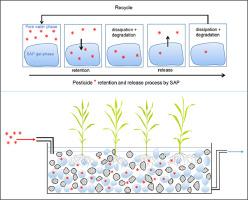Water Research ( IF 11.4 ) Pub Date : 2021-10-16 , DOI: 10.1016/j.watres.2021.117776 Yuying Jing 1 , Martin Krauss 2 , Simon Zschieschang 1 , Anja Miltner 1 , Andrii Butkovskyi 1 , Trine Eggen 3 , Matthias Kästner 1 , Karolina M Nowak 1

|
Surface water runoff can export pesticides from agricultural fields into adjacent aquatic ecosystems, where they may pose adverse effects to organisms. Constructed wetlands (CWs) are widely used to treat agricultural runoff contaminated by pesticides, but the removal of hydrophilic pesticides is usually low. In this study, we suggest superabsorbent polymer (SAP), a cross-linked hydrophilic polymer, as a supplement to substrates of CWs and tested the hypothesis that SAP results in an enhanced removal of hydrophilic pesticides. Therefore, batch experiments were conducted to study the retention capacity of water-saturated SAP (w-SAP) for several hydrophilic pesticides. Retention of the pesticides on w-SAP was related to the ionization state and water solubility of the pesticides. The retention of neutral pesticides, imidacloprid, metalaxyl and propiconazole, was about 20% higher than that measured for anionic pesticides, bentazone, glyphosate and MCPA. The retention of the pesticides by w-SAP mainly resulted from their distribution in the gel-water phase of w-SAP, while less water soluble pesticides might have also been adsorbed on the molecular backbone of SAP. Furthermore, we tested the efficacy of w-SAP for treatment of runoff water contaminated by pesticides in lab-scale horizontal subsurface flow CWs. SAP in CWs improved the removal of the pesticides, including the recalcitrant ones. The removal enhancement was owing to the increase of hydraulic retention time and improvement of biodegradation. The removal of the pesticides in SAP containing CWs was > 93% for MCPA, glyphosate, and propiconazole, 62 – 99% for imidacloprid, 50 – 84% for metalaxyl, and 38 – 73% for bentazone. In the control gravel CWs, the removal was > 98% for glyphosate, generally > 83% for MCPA and propiconazole, 46 – 98% for imidacloprid, 32 – 97% for metalaxyl, and 9 – 96% for bentazone.
中文翻译:

高吸水性聚合物作为人工湿地的补充基质以保留农业径流中的农药
地表水径流可以将农田中的农药输出到邻近的水生生态系统,在那里它们可能对生物造成不利影响。人工湿地(CWs)广泛用于处理被农药污染的农业径流,但亲水性农药的去除率通常较低。在这项研究中,我们建议将一种交联的亲水性聚合物高吸水性聚合物 (SAP) 作为 CW 底物的补充,并验证 SAP 会增强亲水性农药去除率的假设。因此,进行了批量实验来研究水饱和 SAP (w-SAP) 对几种亲水性农药的保留能力。农药在 w-SAP 上的保留与农药的电离状态和水溶性有关。中性农药、吡虫啉、甲霜灵和丙环唑,比阴离子农药、苯达松、草甘膦和 MCPA 的测量值高约 20%。w-SAP对农药的保留主要是由于它们分布在w-SAP的凝胶-水相中,而水溶性较差的农药也可能吸附在SAP的分子骨架上。此外,我们测试了 w-SAP 在实验室规模的水平地下水流 CW 中处理被农药污染的径流水的功效。CWs 中的 SAP 提高了农药的去除率,包括顽固性农药。去除增强是由于水力停留时间的增加和生物降解的改善。MCPA、草甘膦和丙环唑对含有 CW 的 SAP 中农药的去除率 > 93%,吡虫啉 62 – 99%,甲霜灵 50 – 84%,苯达松为 38 – 73%。在对照砾石CW中,草甘膦的去除率> 98%,MCPA和丙环唑的去除率一般> 83%,吡虫啉的去除率46-98%,甲霜灵的去除率32-97%,苯达松的去除率9-96%。











































 京公网安备 11010802027423号
京公网安备 11010802027423号